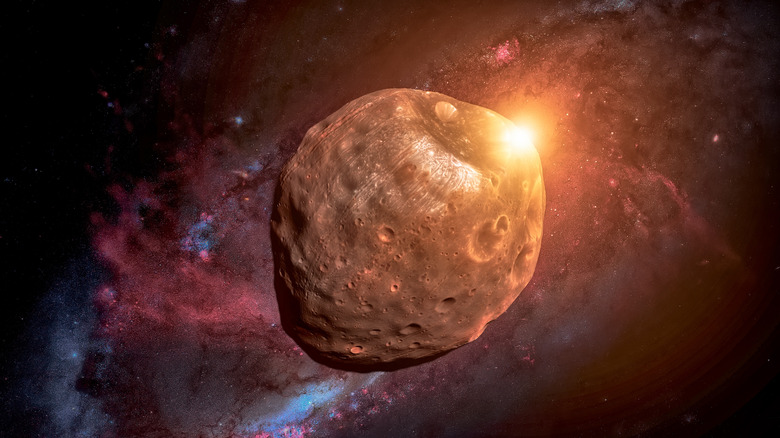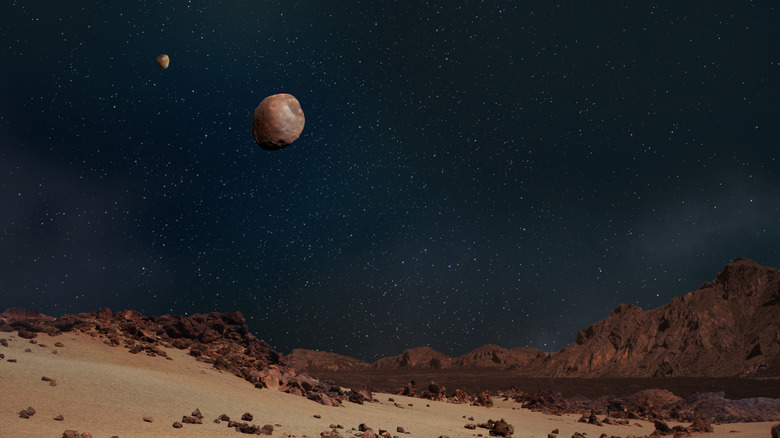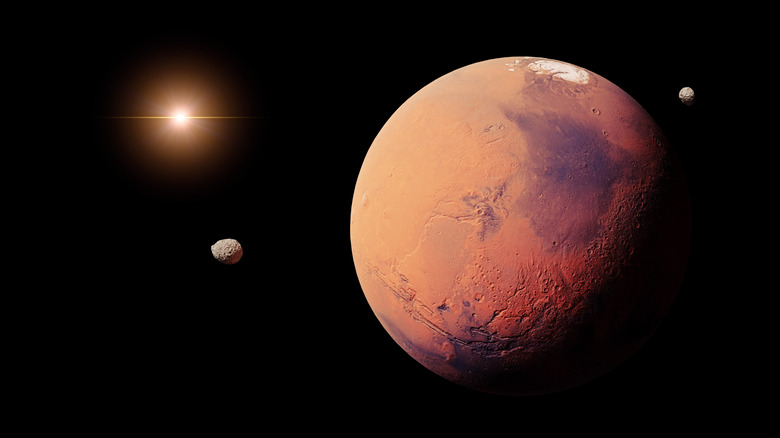This Could Be The Reason One Of Mars' Moons Has Stripes
Astronomers may have just found the answer to the mysterious "tiger stripes" on the surface of Mars' largest moon, Phobos, and the reason doesn't look good. Phobos is currently stuck in an inward spiral toward the planet's surface, and the striped pattern across its surface suggests it's already being ripped apart by Mars' gravity (via Science Alert). According to Terry Hurford of NASA's Goddard Space Flight Center, "we think that Phobos has already started to fail, and the first sign of this failure is the production of these grooves" (via NASA).
Out of the two Martian moons, Phobos is by far the largest. According to Space.com, Phobos is about 7.24 times the size of its sibling, Deimos. Unlike Phobos, Deimos is actually slowly drifting away from Mars, just like our own Moon is drifting away from Earth (via Sea and Sky). So if one of Mars' moons is getting further away from the planet every day, why is the other being ripped apart by gravity as it is pulled closer to Mars' surface? The answer: a boundary in the space around a planet that, once passed, a moon can no longer remain in one piece.
Phobos will be torn apart by gravity before it crashes into Mars
When a moon gets too close to the planet it orbits, the gravity of the planet becomes too strong for the moon to overcome. According to Britannica, this limit is known as the Roche limit, and represents the minimum distance a satellite, such as a moon, can orbit a planet and still remain intact. If a moon were to go inside the Roche limit, the force of gravity of the planet would be greater than the internal gravity that is keeping the moon together, tearing the moon apart as it crashes into the planet's surface (via Space.com).
The Roche limit for each planet is different and depends on its size and mass. Phobos has not yet entered Mars' Roche limit, but we will know when it does. According to Perdue, Phobos will break apart as soon as it enters the Roche limit for Mars, exploding into a spectatular display as its remains scatter into the space where Phobos used to be.
Phobos' remains may create a ring around Mars
So what exactly will take place when Phobos gets too close to Mars? First, we can probably expect to see it begin to tear apart along the grooves that are already appearing on its surface. As one research paper found, "some of the grooves lining the surface of Phobos are likely early signs of the eventual demise of the de-orbiting satellite" (via The Planetary Science Journal).
According to NASA, if Phobos doesn't crash directly into the Martian surface, it will break up into a ring around Mars. Seeing as the moon is already starting to show signs of stress, the second option is becoming more and more likely each day. This ring may look similar, albeit smaller, than the rings around the largest planets in our solar system, Jupiter, Saturn, Uranus, and Neptune. This makes sense, as those planet's rings consist of rock, ice, and dust, which is all that will be left of Phobos (via the Laboratory for Atmospheric and Space Physics). The good news for Phobos is that its inevitable demise is still a long way away. According to NASA, Phobos isn't expected to break apart for another 50 million years. In the meantime, we can study and appreciate Mars' largest moon until it is no longer with us.


